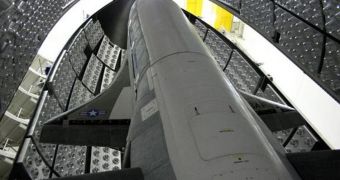Officials with the United States Air Force (USAF) say that there is currently no fixed timetable for the launch of additional X-37B space planes, but add that the possibility is not off the table altogether.
The robotic spacecraft, pegged as mini-space shuttles, are unmanned vehicles capable of reaching low-Earth orbit (LEO), and conducting a host of scientific studies and other experiments all on its own.
Boeing Phantom Works Division thus far built only two such spacecraft for the US military, specifically for the Air Force Rapid Capabilities Office, which is managed by the Pentagon.
USAF launched the first X-37B, also called Orbital Test Vehicle-1 (OTV-1), on April 22, 2010. The spacecraft remained in orbit for 224 days, and landed on December 3 the same year, at the Vandenberg Air Force Base (VAFB), in California.
Both OTV-1 and OTV-2 launched aboard Atlas 5 delivery systems, from the Cape Canaveral Air Force Station (CCAFS), right next door to the NASA Kennedy Space Center (KSC), in Florida.
The second spacecraft of the series took off on Saturday, March 5, and the USAF plans to keep it airborne for as much as 270 days. As usual, all activities the X-37B will perform in LEO are classified.
At this point, there is a great deal of uncertainty among USAF officials as to whether a third mission will launch anytime soon. The CCAFS is one of the few facilities in the US that can accommodate Atlas 5 launches.
But the flight manifest at the spaceport is booked all the way through 2012, and the Air Force is used to launching its missions very close from each other. OTV-2, for example, was launched just three months after OTV-1 landed.
According to specifications released by Boeing, the space plane can also launch on Delta 4 rockets, from the VAFB. However, there is no mention in official USAF documents of any arrangements made to secure such a launch setup in the near future.
“A third flight is anticipated, but no decision has been made for when OTV 3 will launch,” AFRCO X-37B program manager Lt. Col. Troy Giese said, quoted by Space.
“Since OTV 3 would be a re-flight of the first flight vehicle, the refurbishment of that vehicle will play a major part of that decision,” he added. On the other hand, the first spacecraft is not damaged in any significant way, having handled itself remarkably well.
“We do anticipate additional flights in order to meet all of the test objectives, but OTV 1 has not been scheduled for another launch,” Bunko went on to say.
“Because of the short time frame between the landing of OTV 1 on (Dec. 3) and the launch of OTV 2, the team has been busy getting ready for the second test flight,” he added.
“This included a quick-look assessment of the re-entry and landing performance of OTV 1, shipping OTV 2 to the launch base, and integrating OTV 2 to the Atlas 5,” the official concluded.

 14 DAY TRIAL //
14 DAY TRIAL //